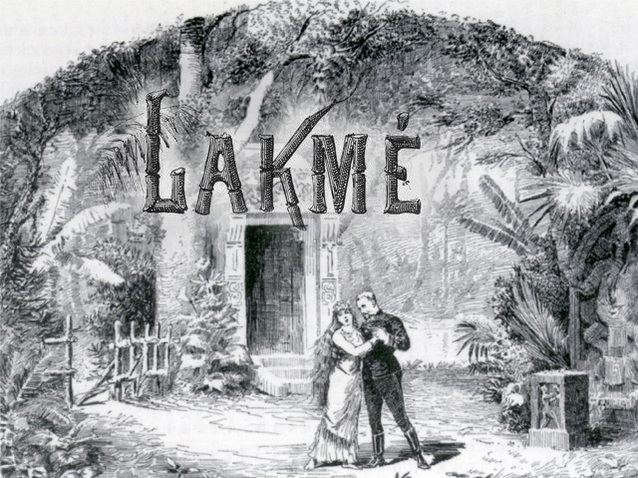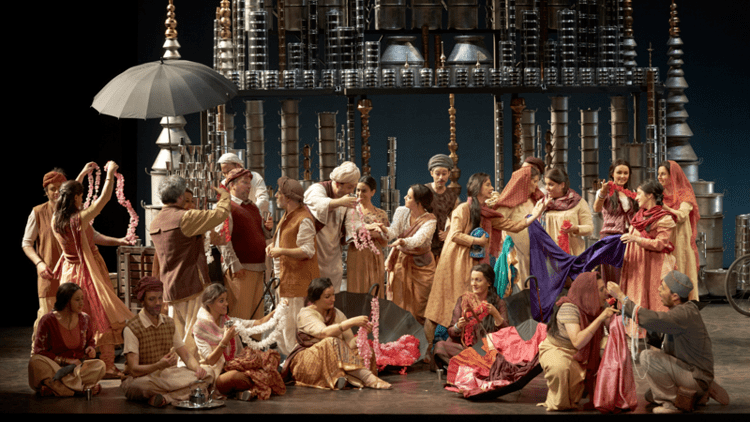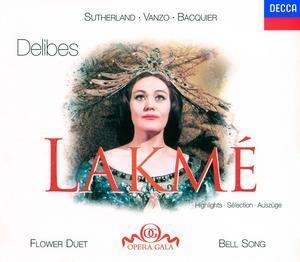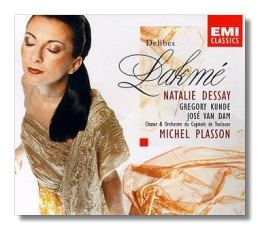Written 1883 Language French | Arias Où va la jeune Hindoue | |
 | ||
Characters Mistress Bentson, Fortune teller, Le Kouravar, Lakmé Similar Manon, The Tales of Hoffmann, Les pêcheurs de perles, Lucia di Lammermoor, Rigoletto | ||
Lakmé is an opera in three acts by Léo Delibes to a French libretto by Edmond Gondinet and Philippe Gille.
Contents

The score, written in 1881-2, was first performed on 14 April 1883 by the Opéra-Comique at the (second) Salle Favart in Paris, with stage decorations designed by Auguste-Alfred Rubé and Philippe Chaperon (Act I), Eugène Louis Carpezat and (Joseph-)Antoine Lavastre (Act II), and Jean-Baptiste Lavastre (Act III). Set in British India in the mid-19th century, Lakmé is based on Théodore Pavie's story "Les babouches du Brahamane" and novel Le Mariage de Loti by Pierre Loti.

The opera includes the popular Flower Duet (Sous le dôme épais) for sopranos performed in Act 1 by Lakmé, the daughter of a Brahmin priest, and her servant Mallika. The opera's most famous aria is the Bell Song (L'Air des clochettes) in Act 2.

Like other French operas of the period, Lakmé captures the ambience of the Orient seen through Western eyes, which was periodically in vogue during the latter part of the 19th century and in line with other operatic works such as Bizet's The Pearl Fishers and Massenet's Le roi de Lahore. The subject of the opera was suggested by Gondinet as a vehicle for the American soprano Marie van Zandt.

Performance history

Following its premiere at the Opéra Comique in 1883, Lakmé reached its 500th performance there on 23 June 1909 and 1,000th on 13 May 1931. A series of performances took place at the Théâtre Gaîté Lyrique Paris in 1908, with Alice Verlet, David Devriès and Félix Vieuille.
Synopsis

Act 1
The Hindus go to perform their rites in a sacred Brahmin temple under the high priest, Nilakantha. Nilakantha's daughter Lakmé (which derives from the Sanskrit Lakshmi) and her servant Mallika are left behind and go down to the river to gather flowers where they sing the "Flower Duet". As they approach the water at the river bank, Lakmé removes her jewelry and places it on a bench. A party of British officers, Frederic and Gérald, arrive nearby while on a picnic with two British girls and their governess. The British girls see the jewelry and request sketches; Gérald volunteers to stay and make sketches of the jewelry. He sees Lakmé and Mallika returning and hides. Mallika leaves Lakmé for a while; while alone Lakmé sees Gérald and, frightened by the foreigner's incursion, cries out for help. However, simultaneously, she is intrigued and so she sends away those who had responded to her call for help when they come to her rescue. Lakmé and Gérald begin to fall in love with each other. Nilakantha returns and learns of the British officer's trespassing and vows revenge on him for his affront to Lakmé's honor.
Act 2
At a bazaar, Nilakantha forces Lakmé to sing (the Bell Song) in order to lure the trespasser into identifying himself. When Gérald steps forward, Lakmé faints, thus giving him away. Nilakantha stabs Gérald, wounding him. Lakmé takes Gérald to a secret hideout in the forest, where she nurses him back to health.
Act 3
While Lakmé fetches sacred water that will confirm the vows of the lovers, Fréderic, a fellow British officer, appears before Gérald and reminds him of his duty to his regiment. After Lakmé returns, she senses the change in Gérald and realises that she has lost him. She dies with honour, rather than live with dishonor, killing herself by eating the poisonous datura leaf.
Music
In conventional form and pleasant style, but given over to the fashion for exoticism, the delicate orchestration and melodic richness earned Delibes a success with audiences. The passionate elements of the opera are given warm and expressive music, while the score in general is marked by subtle harmonic colours and deft orchestration. Oriental colour is used in prayers, incantations, dances and the scene in the market.
The Act 2 aria "Où va la jeune Hindoue?" (the 'Bell Song') has long been a favourite recital piece for coloratura sopranos. (Recordings of it in Italian, as "Dov'e l'indiana bruna?", also exist.)
In recent years, the Flower Duet in Act 1 has become familiar more widely because of its use in advertisements, in particular a British Airways commercial, as well as in films. The aria sung by Lakme and Mallika was adapted for the theme "Aria on air" for the British Airways "face" advertisements of the 1980s by music composers Yanni and Malcolm McLaren.
